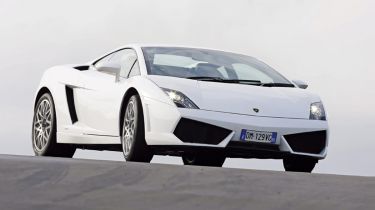Lamborghini LP560-4
Italian thoroughbred is the dictionary definition of a supercar
While Japanese supercars have famously suffered from a lack of charisma in the past, that’s not a criticism you can level at Lamborghini. Even with the calming influence of parent company Audi, the likes of the Gallardo have Italian style oozing from every panel gap. But now, the passion is matched by decent build quality and supermini-simple driveability.
Facelifted earlier this year, Lamborghini’s entry-level model is mightier than ever. The front and rear ends now feature sharper bumpers and air intakes, while the lights have been reworked to give an even sleeker appearance. In the metal, the Gallardo is stunning. The roofline comes up to your waist and overhangs are kept to a minimum; its lack of clutter or unnecessary detail makes the GT-R look bulky and cartoon-like in comparison.
Slide inside the Lambo – easier said than done if you’re six feet tall or more – and you’re instantly cocooned in leather and Alcantara. In true supercar style, the shallow windows and solid rear bulkhead create a dark, snug driving environment, and the narrow sport seats force you into a laid-back position.
But while the materials impress, the Gallardo isn’t perfect. The centre console is packed with Audi switchgear which, although solid and easy to use, is exactly as you would find in an A3.
Used - available now

2016 BMW
5 Series
107,200 milesAutomaticDiesel2.0L
Cash £9,000
2023 Audi
e-tron
48,154 milesAutomaticElectric
Cash £18,000
2015 Volkswagen
Golf GTD
84,621 milesAutomaticDiesel2.0L
Cash £12,000
2016 Tesla
Model S
78,000 milesAutomaticElectric
Cash £18,999Considering that the Lambo costs £130,000 more than the hatch, it’s a shame no effort has been made to give it a more bespoke look. And while we’re on the subject of Gallardo flaws, the pedal box is unforgivable. Although there are only two pedals if you go for the e-gear sequential transmission, both are positioned to the left of the steering column, which leaves no room for your clutch foot.
But while some aspects of the interior design get black marks, it’s hard to find anything negative to say about the way the Gallardo drives. As part of the facelift, Lamborghini replaced the 5.0-litre V10 with a 5.2-litre version which generates 552bhp. It’s a glorious engine and perfectly suited to the Gallardo’s nature. With a guttural bark at low revs and a unique 10-cylinder howl at speed, it accelerates with ferocity and has a seemingly bottomless pit of torque, regardless of your speed.
The heavily revised e-gear transmission is less impressive. The Nissan has the edge for shift quality, but the Gallardo isn’t far behind – it’s just not as smooth. Drivers can choose one of three settings – Normal, Sport or Corsa – with the changes getting sharper and more savage at each level. The Corsa programme also alters the exhaust settings so the V10 howl is even more vocal.
As with the GT-R, the Gallardo uses four-wheel drive to transfer its power to the road. However, the two cars are completely different in character. Where you can feel the Nissan actively juggling the torque between front and rear axles, the Gallardo is more subtle, finely dividing drive to deliver astonishing traction out of corners. It doesn’t have the drama of the GT-R, but it’s just as effective, feels more dramatic even at low speeds, and is a lot more satisfying.
At £147,330, the Gallardo is pricey. Factor in the e-gear box and essential options such as a rear view camera, and the figure exceeds £150,000. However, for sheer presence and desirability, it’s doesn’t get better than this.
Details
Price: £147,330/£147,330
Model tested: Lamborghini Gallardo LP560-4
Chart position: 2
WHY: The Gallardo was revised earlier this year with a new engine and sharper styling. It’s the ultimate Italian supercar.
Economy
A supercar badge on the bonnet comes with proper supercar bills. It’s far from the most expensive model in the Lamborghini stable, but if you have to ask how much the Gallardo costs to run, you probably can’t afford it. And if you’ve got the funds to pay the list price, £400 for a year’s tax disc is probably not going to bother you. Fuel economy of 15mpg could lead to much bigger costs for higher-mileage drivers. And it doesn’t matter how big your bank balance is – getting a bill for £2,800 for the second service will be a major drawback. Insurance is also astronomical.







